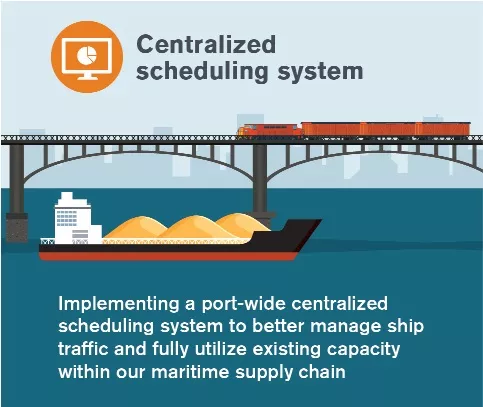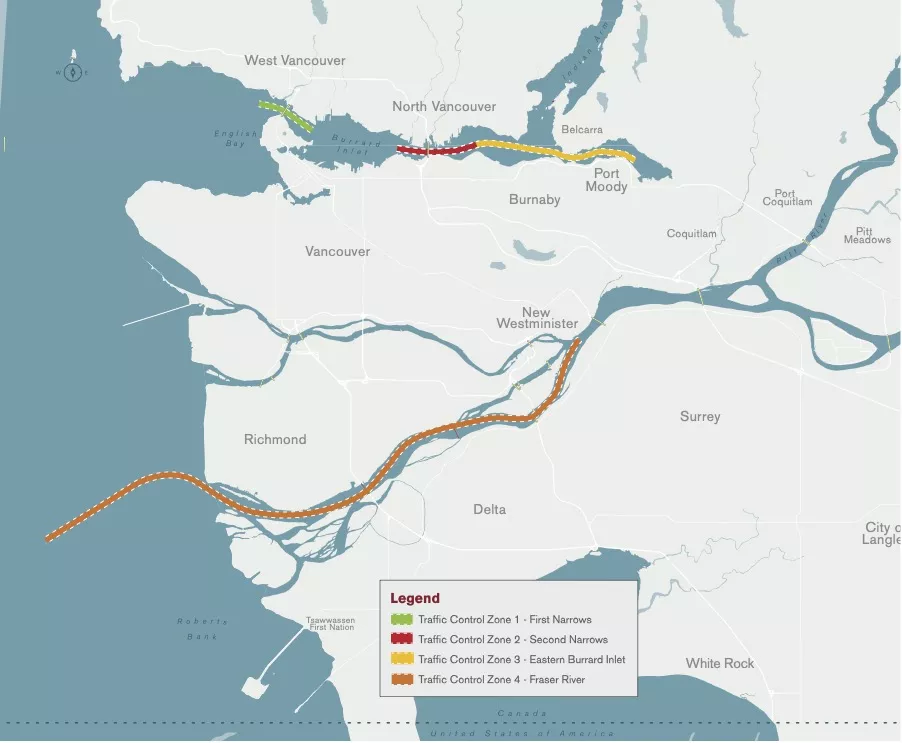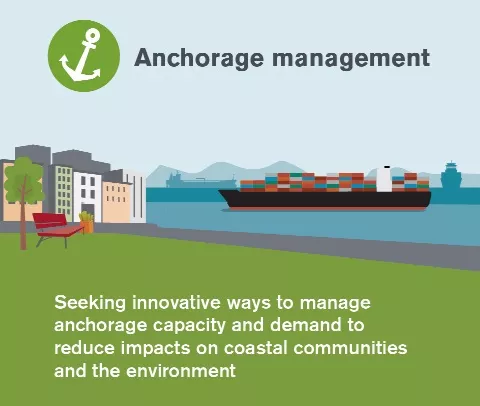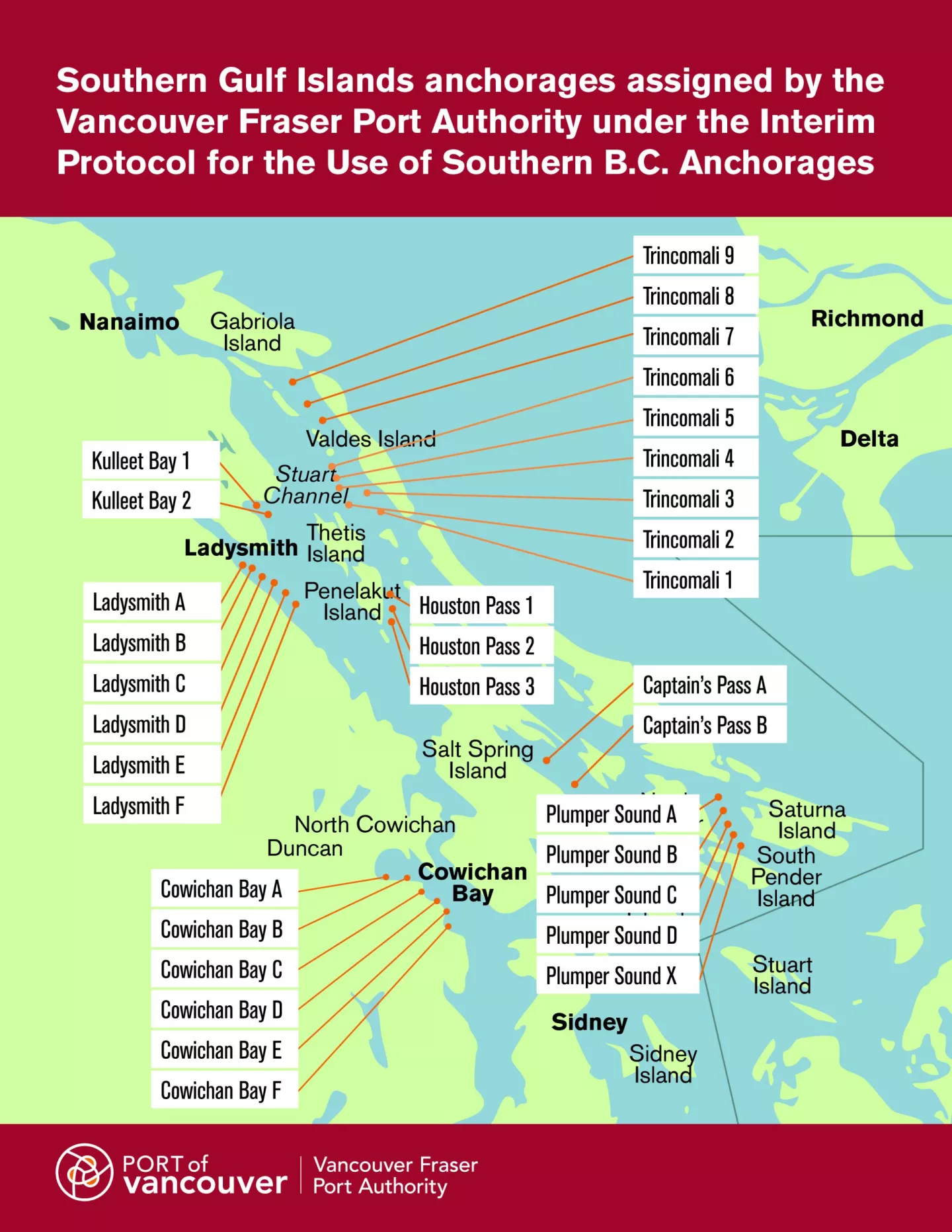
Active vessel traffic management refers to the set of tools, guidelines, and practices we use to prioritize and optimize the movements of commercial ships, tugs, and barges of a certain tonnage within the waters that make up the Port of Vancouver. This coordination work is crucial to ensure cargo is transported safely and sustainably in and out of the port’s confined and increasingly busy waterways and to build an efficient and resilient supply chain able to support the current and future trade activities Canadians rely on.
Contact:
604.665.9004

About the project
The Active Vessel Traffic Management (AVTM) Program is one of the supply chain optimization initiatives led by the Vancouver Fraser Port Authority. It was initiated in 2021 with the goal of helping manage current and future cargo volumes transiting through the Port of Vancouver in a safer and more efficient and sustainable manner.
The program includes the development and implementation of a multi-part active vessel traffic management system to enable the efficient flow of goods to and from the Port of Vancouver and help reduce the environmental and social impacts—such as noise, light, and air emissions—of commercial ship traffic in the region. Fluid and efficient ship movements mean fewer ship-related disruptions to marine users, coastal communities, and the environment, as well as a more competitive and resilient supply chain.
Project benefits
Reducing congestion and actively managing marine traffic in the busiest, most confined waters of the port
Optimizing processes through the gateway, such as vessel-scheduling, for all supply chain partners
Reducing noise impacts to southern resident killer whale habitat by limiting unnecessary vessel movements
Reducing overall anchorage usage in southern B.C. and implementing a code of conduct for vessels at anchorage
Program partners
The AVTM Program brings together several partners, including Transport Canada, the Canadian Coast Guard and Pacific Pilotage Authority, and industry stakeholders whose collective operational experience and perspectives help inform the development of adequate ship traffic optimization tools and protocols. With many parties involved in ship movements, collaboration is key to the success of the program.
In addition to the central role industry plays in shaping the program, Indigenous groups, governments, community stakeholders, and the public also contribute to the development of program initiatives by sharing their interests and providing feedback on specific issues and solutions, such as the code of conduct for ships at anchor. We conducted three phases of engagement to date to identify opportunities to better manage the community effects of commercial ship traffic bound for the Port of Vancouver as we work to increase port efficiency.
Program initiatives
The AVTM Program focuses on the development of policies, practices, incentives, technologies, and data-sharing frameworks that create benefits for all stakeholders and accommodate the various types of cargo that flow through the Port of Vancouver.

As a key component of active vessel traffic management, the centralized scheduling system enables the port authority to prioritize and sequence the movements of cargo ships, tugs and barges in and out of the Port of Vancouver, for enhanced maritime safety and port efficiently. Every day, the system provides the port authority with the best available tide and current data and supply chain insights, allowing us to determine optimal transit windows and schedules based on prevailing demands, needs and circumstances.
Over time, the efficiency gained through active vessel traffic management and the use of the centralized scheduling system will increase cargo throughout capacity at the Port of Vancouver as well as the overall reliability and competitivity of our maritime supply chain. By improving ships’ turnaround times at the port, the system will also help reduce the use of commercial anchorages and associated impacts—noise, light, air pollution—on coastal communities and the environment.
The centralized scheduling system is currently being used to manage the traffic of trade-enabling vessels transiting through the Second Narrows (Traffic Control Zone 2), Burrard Inlet’s busiest waterway. It will be extended to other traffic control zones across our jurisdiction in later phases of the program. Learn more
Overview of traffic control zones within the Vancouver Fraser Port Authority’s jurisdictional waters:


Anchorage code of conduct (in effect since February 2023)—as part of our commitment to reduce the impact of ship traffic on coastal communities and the environment, we implemented the first anchorage code of conduct in Canada. The code of conduct outlines the practices we ask ship operators anchoring at the Port of Vancouver and around the Southern Gulf Islands to follow to minimize disruptions—such as the ones caused by noise and light—and be good neighbours.
Arrival and departure window for ships anchoring around the Southern Gulf Islands (in effect since July 2023)—to further balance trade objectives and shipping impacts and mitigate nighttime noise disruptions from anchoring operations in the region, the port authority is asking ship operators to prioritize arriving at or departing from 33 Southern Gulf Islands anchorages between 7:00 a.m. and 11:00 p.m., when feasible, and subject to logistics and safety-based exceptions.

Anchorage management protocol—in collaboration with industry stakeholders and supply chain partners, we are in the process of reviewing our current approach to managing anchorages at the Port of Vancouver and defining the principles of a modernized anchorage management protocol and vessel arrival framework that consider the trade levels, operational challenges, and community concerns of today and tomorrow.
Alternative mooring solutions—considering community feedback, we are exploring the feasibility of using a mooring system to increase anchorage capacity at the Port of Vancouver and ease the pressure on anchorages in the Southern Gulf Islands. Assessment studies, including analyses of operational and economic feasibility for a dolphin mooring system that could be considered in and around the Vancouver harbour, are underway.
Why is active vessel traffic management needed?
As Canada’s largest port and home to 29 major terminals, the Port of Vancouver handles the most diversified range of cargo in North America: bulk (such as grains, coal, and fertilizers), containers, breakbulk (such as oversized goods and equipment), liquid bulk (such as petroleum products and cooking oils), cars, and passengers (cruise). On average, around 3,000 ships call the port every year, and with growing demand, this number is set to increase.
With increased cargo volumes moving through the Port of Vancouver comes increased complexity and challenges in managing the efficient movement of ships, emphasizing the necessity for active vessel traffic management to help prevent conflicts between a variety of ships serving different commodity sectors, and other modes of transportation placing demand on waterways. This includes accounting for larger ships, tidal windows, and transit times to and from terminals, and competing demand.

A program building on data, experience and collaboration
The scope of the AVTM Program was first defined by an advisory panel composed of members from the maritime and supply chain sectors and informed by the results of an option and feasibility analysis of ship traffic management conducted by the port authority in 2020, with input from industry. The following areas of opportunities for the development of an active vessel traffic management system were identified:
- Reducing inefficiencies in the gateway and associated loss of productivity or costs to users
- Providing a safe, more fluid and consistent traffic flow
- Enhancing cooperation between the Vancouver Fraser Port Authority, Canadian Coast Guard, and Pacific Pilotage Authority given shared responsibilities in some areas
- Using real-time information to make traffic scheduling decisions to meet existing demands and provide a responsive traffic management pattern
To this day, industry stakeholders—terminal operators, shippers associations, tugs and barge operators, marine pilots, and more—continue to play a crucial role in helping shape and implement program initiatives. They engage in ongoing workshops and provide invaluable expertise and insight into supply chain logistics, challenges, and optimization opportunities.
